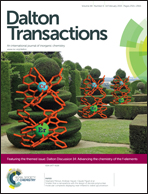A novel [4 + 3] interpenetrated net containing 7-fold interlocking pseudo-helical chains and exceptional catenane-like motifs†
Abstract
A novel interpenetrating metal–organic framework, namely [Zn3L2(oba)3(H2O)2]·4H2O (1), has been synthesized under hydrothermal conditions. Its structure was determined by single-crystal X-ray diffraction analysis and further characterized by elemental analysis, IR, and thermogravimetric (TG) analysis. In the structure of 1, the rigid and flexible V-shaped ligands link Zn(II) to form a 3D structure where two types of helices and four types of pseudo-helical chains containing three pairs of enantiomers and two pairs of conformational isomers have been characterized. One such 3D framework incorporates six identical networks to form a 7-fold interpenetrated 3D framework. From the topological analysis, the Zn(II) ions act as three- and four-connected nodes, and oba as well as L are linkers. The framework of compound 1 can be classified as a new (63)2(65·8) topology, which is a novel (3,3,4)-connected [4 + 3] 7-fold interpenetrating net showing 7-fold interlocking pseudo-helical chains and a unique catenane-like motif with Hopf links. In addition, the luminescence properties of the compound are discussed.
![Graphical abstract: A novel [4 + 3] interpenetrated net containing 7-fold interlocking pseudo-helical chains and exceptional catenane-like motifs](/en/Image/Get?imageInfo.ImageType=GA&imageInfo.ImageIdentifier.ManuscriptID=C4DT02808B&imageInfo.ImageIdentifier.Year=2015)

 Please wait while we load your content...
Please wait while we load your content...